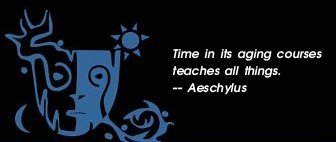|

The Fairy Tale Forest
Copyright © 2006 by Karen Elizabeth Guerin
[Image: Pine Forest Spiral ©by Stu Jenks]
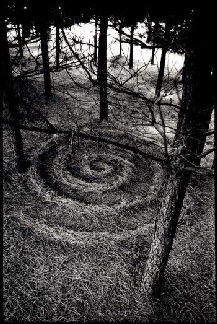 Trees and forests have played a significant role in folklore and fairy tales from the dawn of recorded history. The mythological World Tree was a virtual map of the cosmos for the journeying shaman, and remnants of the idea of the tree as a symbol for the universe are found in folklore and fairy tales of various cultures throughout the world. Pre-Christian religions gathered in sacred groves and even worshipped certain trees for various reasons that were known only to them because they had no written sacred texts. Later in the literature of the Middle Ages, forests came to represent the edge of civilization and the unconscious part of the human mind, a place of mists where magical beings thrive and transformations happen to characters that wander into the shadows of the ancient trees. For these reasons, the symbol of the forest forms a considerable repository of folkloric knowledge. Trees and forests have played a significant role in folklore and fairy tales from the dawn of recorded history. The mythological World Tree was a virtual map of the cosmos for the journeying shaman, and remnants of the idea of the tree as a symbol for the universe are found in folklore and fairy tales of various cultures throughout the world. Pre-Christian religions gathered in sacred groves and even worshipped certain trees for various reasons that were known only to them because they had no written sacred texts. Later in the literature of the Middle Ages, forests came to represent the edge of civilization and the unconscious part of the human mind, a place of mists where magical beings thrive and transformations happen to characters that wander into the shadows of the ancient trees. For these reasons, the symbol of the forest forms a considerable repository of folkloric knowledge.
One of the most famous trees in mythology is a huge ash tree known as Yggdrasil, the World Tree of the Scandinavian Poetic Eddas, upon which the Allfather of the Norse pantheon, the god Odin, hung himself upside down for nine days and nights, out of a fierce desire to acquire the runes of power. He had to forfeit an eye to the underworld giant Mimir who lived in the sacred well at the base of the tree before he could finally grasp the runes. With roots that penetrate the depths of the abyss, and huge limbs that spread over the world and tower above heaven, Yggdrasil is characteristic of the World Tree that is the axis of the earth and all of creation, around which everything rotates (Campbell 121). Like the infamous Tree of the Knowledge of Good and Evil in the Garden of Eden, Yggdrasil has a resident serpent, but one that perpetually gnaws away at the roots.
As an ancient symbol of the Neolithic goddess religion, the serpent is also commonly associated with various versions of the World Tree in ancient mythologies (Campbell 191, 387). In examining portrayals of the World Tree in shamanic cultures throughout the world, but especially in northern circumpolar cultures such as Siberian and Scandinavian, Mircea Eliade traced the Cosmic Tree to its origins in the Mesopotamian cultures of the Indus Valley, which of course, informed the biblical story of the tree in Eden, and also to ancient Oriental cultures in the Far East (270). Siberian and Altaic shamans, and their related linguistic branches, have been observed to practice their journeys to the celestial realm of the spirits in a yurt with a pillar in the center that represents the World Tree, often referred to as the Cosmic Pillar and the Celestial Tree. "Yggdrasil," the name of the Scandinavian Cosmic Pillar meaning "steed of Ygg," refers to Odin's horse. Like the tree, the horse is also an important symbol because it facilitates and assists in transporting the shaman to the other worlds where the spirits reside. Here, these two symbols obviously intertwine.
 In many mythologies, the World Tree has either seven or nine branches, each representing another world or level of non-ordinary reality, and the shaman placed notches on the pole to mark these different levels as he travels to them. This magico-religious belief system using the tree and the horse illustrates the shamans' relationship to nature and the cosmos; everything is alive and interrelated. Not only is the tree a symbol of the heavens in primitive religions, but also of the sacredness of creation of the earth, its fertility and the annual return of vegetation, relating to fecundity and initiation, and finally, immortality (Eliade 271). Thus, the tree took an important place in creation myths that were later inserted into traditional, especially oral, folklore as shamanic legends (Novik). This idea directly points to that other tree in the Garden of Eden, the Tree of Immortality, which was a common theme in many Eastern and Oriental mythologies that informed later cultural myth cycles. In many mythologies, the World Tree has either seven or nine branches, each representing another world or level of non-ordinary reality, and the shaman placed notches on the pole to mark these different levels as he travels to them. This magico-religious belief system using the tree and the horse illustrates the shamans' relationship to nature and the cosmos; everything is alive and interrelated. Not only is the tree a symbol of the heavens in primitive religions, but also of the sacredness of creation of the earth, its fertility and the annual return of vegetation, relating to fecundity and initiation, and finally, immortality (Eliade 271). Thus, the tree took an important place in creation myths that were later inserted into traditional, especially oral, folklore as shamanic legends (Novik). This idea directly points to that other tree in the Garden of Eden, the Tree of Immortality, which was a common theme in many Eastern and Oriental mythologies that informed later cultural myth cycles.
Frazer says, "in the religious history of the Aryan race in Europe the worship of trees has played an important part" (126). Caesar and other Romans documented the expansiveness and the intense solitude of the vast ancient European forests. The memory of these legendary forests from Italy to England has survived in folklore. Jacob Grimm determined from his research on the Teutonic word for "temple" that the oldest sanctuaries for the German tribes were probably in the woods (Frazer 127). This was also the case for the priests of the Druid Religion of the Celtic and Gallic tribes, who apparently worshipped their deities in oak groves.
The Celtic name of "Drynemetum" means "the sacred oak grove" and was the setting of the place of the Galatian senate in Asia Minor, so the Druid religion may have originated in Mesopotamia and migrated westward into central Europe with the conquering Celtic tribes (Frazer 186). In his Natural History XVI, Pliny notes that the word "Druid" is the Greek word for "oak" and further says about the druidic religion, "The magicians perform no rites without using the foliate of those trees" (Green 9). Interestingly, the oak tree is also associated with Jupiter/Zeus for the Romans and Greeks.
But unfortunately, the Druids had no written texts, so the details of their history and religion have been lost, and can only be speculated from often biased Roman observations. Because of the Roman conquest of Gaul around the first century B.C.E., there is a large body of folklore surrounding mysterious Druids from late Classical times to the present. In the first century A.D., Pliny the Elder describes a ceremony in Gaul in which white-clad Druids climbed a sacred oak and with a small sickle cut some mistletoe growing on it, and then sacrificed two white bulls and used the mistletoe to cure infertility (Green 18). This image has greatly influenced even modern day perceptions of Druidism.
The mistletoe seems to be just as important as the oak tree for the Druids in Pliny's description, but oak groves were definitely maintained as gathering places for worship. In fact, when the Druids became troublesome to the conquering Roman government because of their political power over the Gallic clan leaders, the Roman armies were sent in to burn and destroy the sacred groves (Green 15). This method, along with systematic genocide of the priests, effectively destroyed the Druidic religion, along with the ancient Oaks, and relegated them both to the pages of speculative history.
Nevertheless, the vestiges of the ancient Druidic religion survived in the mythology of the Celts, which went on later to form a rich body of folklore known as the Breton lays. The forest became a supernatural place of mystery and the residence of magical beings, certain species of trees were deemed sacred, and some were even animated. Storytellers and minstrels known as Bards brought the Celtic myths, folktales and Breton lays with them across the English Channel and they were later the sources for the French fairy tale literary tradition that flourished in the Middle Ages (Loomis 11). For the educated elite, such as medieval authors Marie de France and Cretien de Troyes, these stories also integrated images from Classical storytellers such as Ovid and Tacitus, of wood nymphs known as dryads and other nature spirits who inhabited trees and woods (Porteous 111). Many French fairy tales are set in the famous Broceliande Forest of Brittany, where magical, and sometimes dark and foreboding things happen to the characters (Loomis 17).
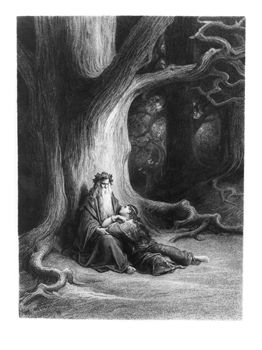 Broceliande Forest was the shadowy lair of the wizard Merlin of Arthurian romance fame. Arthurian romance is a branch of the fairy tale tradition that derives directly from Welsh folklore and Breton lays about the adventures of King Arthur and his knights, who are prime examples of legendary folk heroes. The forest features prominently in these tales as a hideout for wizards and fairy queens, and a place of entry into another world. It is in the forest that the Arthurian knight would search for the Grail Castle and occasionally be abducted by the Fairy Queen. One of the most famous knights of medieval romance, Lancelot du Lac retreats to the forest on four separate occasions to recover from the emotional and psychic wounds from both love and battle (Harrison 67). He becomes a raving wild man each time, more animal than civilized human, the archetypal wild man, or the beast/man. The wild man is denizen of woodland folklore who represents the shadow of civilized society and the forest is his hideout (Harrison 65-69). Broceliande Forest was the shadowy lair of the wizard Merlin of Arthurian romance fame. Arthurian romance is a branch of the fairy tale tradition that derives directly from Welsh folklore and Breton lays about the adventures of King Arthur and his knights, who are prime examples of legendary folk heroes. The forest features prominently in these tales as a hideout for wizards and fairy queens, and a place of entry into another world. It is in the forest that the Arthurian knight would search for the Grail Castle and occasionally be abducted by the Fairy Queen. One of the most famous knights of medieval romance, Lancelot du Lac retreats to the forest on four separate occasions to recover from the emotional and psychic wounds from both love and battle (Harrison 67). He becomes a raving wild man each time, more animal than civilized human, the archetypal wild man, or the beast/man. The wild man is denizen of woodland folklore who represents the shadow of civilized society and the forest is his hideout (Harrison 65-69).
The oldest literary version of this motif may be Gilgamish's sasquatch-like friend, Enkidu, from Sumerian mythology, but another obvious Classical source again is Pan, whom the Arcadians called the "Lord of the Woods" (Porteous 118). As a satyr, Pan was highly libidinal, obsessed with chasing nymphs when he wasn't hunting game. These two associations with the forest have remained in folk and fairy tales, the forest as the dwelling place of lovely nymphs and the hunter or woodsman's home. The Pan figure may also be the origin of the Green Man of the Celts, whose leafy face is often found in carvings on the doors and entryways of old churches in England and France and who is no doubt a fertility figure. The Green Knight and his "Green Chapel in the northern woods," of early medieval literature is surely a later version of this pagan nature spirit who resides in the woods (Markale 213-214).
Also residing in the woods were outlaws, who counted on concealment to survive, such as Robin Hood of England's infamous Sherwood Forest, dwelt deep in the medieval forest to avoid society's authority (Harrison 79). The forest provided the perfect canopy for disguise and its shadows a safe haven. Robin Hood's stealthiness became legendary along with his green garb. Like the Green Man forest spirit, he was elusive because of his unity with the forest, and he wore its protection out in the world.
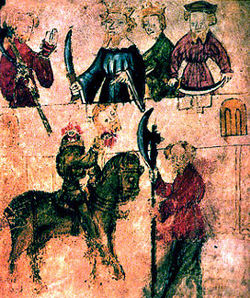 The frightening Green Knight of Arthurian lore and the fertility forest god, the Green Man, merge in the Wild Huntsman legends of English and German origin. In these legends, a hunter dies, but first is cursed to forever hunt, and haunt, a particular wood, especially on certain nights. The Wild Hunt is also a variation of an ancient Scandinavian myth about Odin's travels through the sky with his wild hoarde of ghostly warriors from Valhalla (Porteous 100). If one happened to be in the forest at night, one could easily end up being chased through the forest by the wild hoarde or the Wild Huntsman and his pack of otherworldly dogs, and it has not been described as a pleasant experience. This author has heard, from a friend in Britain, a first hand account of the terrifying experience of being chased through the woods by the Wild Huntsman. The frightening Green Knight of Arthurian lore and the fertility forest god, the Green Man, merge in the Wild Huntsman legends of English and German origin. In these legends, a hunter dies, but first is cursed to forever hunt, and haunt, a particular wood, especially on certain nights. The Wild Hunt is also a variation of an ancient Scandinavian myth about Odin's travels through the sky with his wild hoarde of ghostly warriors from Valhalla (Porteous 100). If one happened to be in the forest at night, one could easily end up being chased through the forest by the wild hoarde or the Wild Huntsman and his pack of otherworldly dogs, and it has not been described as a pleasant experience. This author has heard, from a friend in Britain, a first hand account of the terrifying experience of being chased through the woods by the Wild Huntsman.
There is possibly an even older, but still related, European version of the forest gods, who shows up as the hunter's counterpart, a majestic stag. Campbell also notes in Primitive Mythology that there are four stags that run along the branches of Yggdrasil (120). The stag god is evidently a very old god because Paleolithic portrayals of him have been found on cave walls in France, and archeological artifiacts with his image have been unearthed in northern Europe (Green 58-59).
The antlered stag god figures prominently in Arthurian lore as a representative of the sacrificed god, and thus as an archetypal symbol, was easily molded into a Christian image (von Franz 258-259). But, there is no doubt that he is much older and was once the European King of the Woods. In fact, the Stag of Rhedenvre appears in the Welsh Mabinogian, in the story of Kulhwch and Owen, which is considered to be a very early saga of Arthur. The questing heroes approach the Stag for information because he is the oldest animal they know (Markale 197).
Renowned Jungian analyst and author, Marie-Louis von Franz notes that, "In many fairy tales and poems the forest is the starting point for the journeyings and deeds of the hero. This represents emergence from a relatively unconscious situation into a far more conscious one." She points out that the Arthurian fairy-tale hero Perceval grows up in a forest, with the forest symbolizing the child's consciousness, because of its plant and animal life and its restricted horizon (39). The child's world consists more of archetypal forms and images than of ordinary people (von Franz 42).
Because of the perpetual twilight of the forest, it is a liminal place of encounters with the imagination of childhood, the fairy tale world. Perhaps this is why fairy tales have sometimes been viewed by psychologists as "coming of age" myths. The forest represents the numinous world of the child's psyche, and the child, like Hansel and Gretel, has to fight her way past the witch or like Snow White, find spirit helpers such as dwarves to help her.
Von Franz asserts that the numerous legends about the seduction of the would-be valorous knight by forest nymphs and fairy women is about the pull back to childhood, and especially the desire for the mother, who is represented by the forest. She claims that this "seduction of sinking back into the unconscious is a widely known human experience which has found expression most particularly in folklore and fairy-tales" (43). Thus, from a Jungian perspective, the forest is essentially a battleground between the real and the unreal world, the higher consciousness of the mature adult, and the lower world of childhood fantasy (Heuscher 303-302).
The hero is challenged to fight his own inner demons, usually in the form of sensuous women, but sometimes as a predatory Black Knight or dragon. The Jungian approach also supports the motif of the hero who loses his reason and rushes off into the forest, where he regresses into the wild man state until he is reunited with his lady. This is analogous to the problem of soul loss from the emotional reality of the civilized world, and the retreat into the forest to regain the soul, which is feminine in medieval allegory (von Franz 180). According to Heuscher, a psychiatrist specializing in myths and fairy tales, "The wood is a common symbol for the human being's loss or abandonment of previous values and securities" (117).
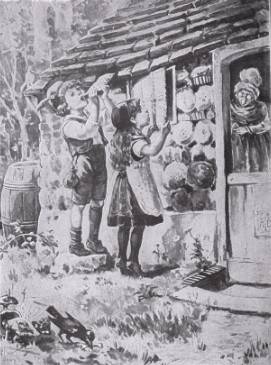 Fairy tales are full of images of loss and abandonment; Snow White is cast out by her narcissistic mother into a dark and perilous forest, and Little Red Cap deviates intentionally from the correct path. Hansel and Gretel are rejected and cast out by unloving parents and once abandoned in the woods, cannot find their way home, becoming increasingly lost in the depths of the deep forest, where only a cannibalistic witch lives. Many fairy tales have a "house in the middle of the woods" motif. This is a house that is very different from the one in which the hero or heroine had previously lived outside of or "on the edge" of the woods, in civilization. But, it is a house they must encounter nevertheless, because civilization has thrown them out. Fairy tales are full of images of loss and abandonment; Snow White is cast out by her narcissistic mother into a dark and perilous forest, and Little Red Cap deviates intentionally from the correct path. Hansel and Gretel are rejected and cast out by unloving parents and once abandoned in the woods, cannot find their way home, becoming increasingly lost in the depths of the deep forest, where only a cannibalistic witch lives. Many fairy tales have a "house in the middle of the woods" motif. This is a house that is very different from the one in which the hero or heroine had previously lived outside of or "on the edge" of the woods, in civilization. But, it is a house they must encounter nevertheless, because civilization has thrown them out.
Bears, dwarves, fairies, witches, or other magical beings or animals already occupy the house in the woods. The hero or heroine who arrives there, by accident, is from the outer world, the human world, but is either lost or in exile from it. They are in need of sustenance or support, which the magical beings either provide or deny, contingent on the accomplishment of certain tasks. This is a concept that points back to the ancient European shamanic cultures, in which the priest/shaman would undergo various initiation experiences involving spirit beings and animal spirits. A shamanic reading of Little Red Cap indicates that Grandmother's house in the wood is a place of transformation for the girl.
The wood is a place of both nourishment and of testing and initiation for the hero or heroine, who usually gains something important and beneficial from their interaction with the magical beings that reside in the forest. Little Red Cap gains something from being eaten by the wolf, because being consumed by a power animal is a recurring motif in shamanic legends. This motif shows up in Judeo-Christian folklore as well, in the well-known story of Jonah being eaten by the whale. Because civilization is ordered and regulated by human laws, the forest is often the setting for these transformations and interactions. Harrison says, "forests represent an inverted world, or the shadow of irony itself. . .deception serves ultimately to unmask the deceptive veneers of the ordinary, legitimate world" (80).
Because the oldest traditions are preserved in folktales, the Grimms associated Germanic culture with the forests. They conceived of forests as "symbolic preserves of the popular and oral traditions . . . " In 1813 they published Old German Forests, a journal which linked German forests to the beginning and continuation of German culture (Harrison 168). The Grimms evidently were aware that the natural unity implicit in the fairy tale forest stories and the human/animal relationships that occurred in them were the residue of a more organic way of life that was largely lost by the end of the Renaissance (Harrison 173). Many of the stories portend the kind of angst that occurs in modernity, in which separation from nature, because of urbanization, is a prevalent fact of life. By the same token, many of the stories emphasize reunification, healing and restoration. Therefore, the fairy tale forest represents not only what is lost, but a place where what is lost can be restored.
This is the purpose of a temple, giving credence to the phrase "cathedral forest." Before there were gothic cathedrals with monstrous spiraling columns and buttresses, there were giant trees reaching toward the heavens. Amongst the trees, on the fertile loam were innumerable insects and animals that roamed at will, perpetually aware of the then harmonious balance between predator and prey. Humankind was among these animals, and thus the idea of sacred groves as places of communion with each other and the spirits developed. Animals would appear in and out of the shadows and mists as signs and signals and sometimes the priest/shaman/Druid would call them.
The sacred groves are no longer in use, the planet is being deforested, and even the famous German Black Forest suffers from an incurable disease. It's a good thing that we have the stories to help us remember the forest, and what can happen there to a little girl and boy who are clever and can work together. Evil witches are killed, dragons are slain, trolls are out-witted, fairies are supped with, animals are conversed with and dwarves are relied on for assistance. Bad things are overcome and children emerge from the fairy tale forest older and wiser and ready to face the dragons of the "real" world, the monsters of human civilization. Because of their encounter with the fertile and renewing forest world, they have acquired a relationship with nature that, like the treasure chest of gold coins and gems, or magic beans, enriches their lives and banishes spiritual poverty.
Although the origins of the idea of the World Tree, the Cosmic Pillar, the Celestial Tree, and the Cosmic Tree are now obscure, the tree has become in modern times a metaphor for the progression of civilization. The historical cultural travels of myth and language have been illustrated as a branching tree, with the primary ones being the trunk and the sources being the roots. Computer programming is often described using the metaphor of tree branches. The Tree of Life, that ancient mythological tree, has survived, ironically, in modern science because the tree metaphor is uniquely suited to genetics. But, as the Grimm brothers noted, the imagery of trees and forests winds deeply into the folk memory of the common people, and finds its greatest expression in fairy tales.
Works Cited
Campbell, Joseph The Masks of God. Vol. 1. New York: Viking, 1959
Eliade, Mircea. Shamanism, Archaic Techniques of Ecstasy. Princeton: Bollingen, 1964
Frazer, Sir James. The Golden Bough, A Study in Magic and Religion. 1922. Vol.1, Abridged Ed. New York: Touchstone, 1996.
Green, Miranda J. The World of the Druids. New York: Thames and Hudson, 1997.
Harrison, Robert Pogue. Forests: The Shadow of Civilization. Chicago: The University of Chicago Press, 1992.
Heuscher, Julius E. M.D., A Psychiatric Study of Myths and Fairy Tales, Their Origin, Meaning and Uselfulness. 2nd Ed. Illinois: Charles C. Thomas, 1974.
Jung, Emma and Marie-Louis von Franz. The Grail Legend. 2nd Ed. Trans. Andrea Dykes. Princeton: Princeton, 1970.
Loomis, Roger Sherman. The Grail: From Celtic Myth to Christian Symbol. 1963. Princeton: Princeton University Press, 1991.
Markale, Jean. King of the Celts: Arthurian Legends and the Celtic Tradition. 1976. Trans. Christine Hauch. Rochester, Vermont: Inner Traditions, 1994.
Novik, Elena S. "The Archaic Epic and Its Relationship to Ritual" from Ritual and Folklore in Siberian Shamanism. Ed. Marjorie Mandelstam Balzer in Shamanic Worlds, Rituals and Lore of Siberia and Central Asia. London: North Castle, 1997.
Porteous, Alexander. The Forest in Folklore and Mythology. 1928. New York: Dover, 2002.
Return to Mythic Passages Menu
Subscribe to the Mythic Passages e-magazine
|
